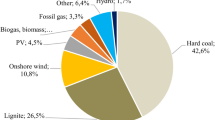Abstract
Malaysia is one of the few developing countries rich in natural resources and it aims to achieve a high renewable energy penetration by the end of 2030. Malaysia’s energy sectors are rapidly evolving due to increasing energy demand in the country. Therefore, the use and development of renewable energy should be emphasized, not only to reduce its dependence on fossil fuel resources, but also to reduce the impact of fossil fuels on climate change. This study aims to comprehensively review renewable energy resources and non-renewable energy resources that can be utilised at least possible costs. Malaysia currently relies heavily on fossil fuels such as natural gas, coal and crude oil for its energy production. This paper explores the energy sector in Malaysia in broad terms, and particularly examines the diversification of its energy production to achieve a least cost configuration. The roles of renewable energy and nuclear energies as alternatives to close the gap of depleting fossil fuels and growing energy demands to improve energy supply security in fuel diversification are also explored using system dynamics to provide a clear understanding of the least cost option for an optimum energy penetration for Malaysia.
Access this chapter
Tax calculation will be finalised at checkout
Purchases are for personal use only
Similar content being viewed by others
References
Loo TG, Abdul Malek B, Hadri Haris A (2010) APEC expert group on new and renewable energy technologies (EGNRET), pp 1–7, 2010
Asia Pacific Research Centre (2013) APEC energy demand and supply outlook, 5th edn.
International Energy Agency (2015) Southeast Asia energy outlook 2015
Energy Commision (2016) Peninsular Malaysia electricity supply industry outlook 2016, p 73
Choong J (2019) Yeo: Malaysia aiming for 20 pc renewable energy use by 2025. Malay Mail
Unit EP (2011) The new energy policy—national energy security 2012. EPU 1(1):19
Mekhilef S, Safari A, Mustaffa WES, Saidur R, Omar R, Younis MAA (2012) Solar energy in Malaysia: current state and prospects. Renew Sustain Energy Rev 16(1):386–396
Seong C, Lalchand G (2014) A review on sustainable power generation in Malaysia to 2030: historical perspective, current assessment, and future strategies. Renew Sustain Energy Rev 29:952–960
Lim CH, Elias S, Jones P (2006) Renewable energy policy and initiatives in Malaysia, pp 1–8
Shahmohammadi S, Yusuff HSGRM, Mahmoud Sadat M (2014) Long term policy analysis of Malaysia’s renewable energy fund budget: a system dynamics approach, pp 1–22
Association MG (2014) Malaysia: natural gas industry annual review—2014 Edition
U.S. Energy Information Administration (2017) EIA—Malaysia. In: Independent statistics and analysis [Online]. Available https://www.eia.gov/international/overview/country/MYS
Ong HC, Mahlia TMI, Masjuki HH (2011) A review on energy scenario and sustainable energy in Malaysia. Renew Sustain Energy Rev 15(1):639–647
BE Sustainable (2012) Malaysia’s biomass potential [Online]. Available https://www.besustainablemagazine.com/cms2/malaysias-biomass-potential/
TNB Malaysia (2016) TNB Handbook, pp 1–38
Campoccia A, Dusonchet L, Telaretti E, Zizzo G (2020) Comparative analysis of different supporting measures for the production of electrical energy by solar PV and Wind systems : four representative European cases. Sol Energy 83(3):287–297
Sterman JD (2000) Business dynamics: systems thinking and modeling for a complex world. McGraw-Hill
IOM UN Migration (2017) IOM in your country—Malaysia [Online]. Available https://www.iom.int/countries/malaysia
Author information
Authors and Affiliations
Corresponding author
Editor information
Editors and Affiliations
Rights and permissions
Copyright information
© 2021 The Author(s), under exclusive license to Springer Nature Singapore Pte Ltd.
About this paper
Cite this paper
Cheok, J.J., Tan, A.H.P., Yap, E.H., Wong, KC., Goh, B.H. (2021). Least Cost Option for Optimum Energy Penetration in Malaysia. In: Osman Zahid, M.N., Abdul Sani, A.S., Mohamad Yasin, M.R., Ismail, Z., Che Lah, N.A., Mohd Turan, F. (eds) Recent Trends in Manufacturing and Materials Towards Industry 4.0. Lecture Notes in Mechanical Engineering. Springer, Singapore. https://doi.org/10.1007/978-981-15-9505-9_13
Download citation
DOI: https://doi.org/10.1007/978-981-15-9505-9_13
Published:
Publisher Name: Springer, Singapore
Print ISBN: 978-981-15-9504-2
Online ISBN: 978-981-15-9505-9
eBook Packages: EngineeringEngineering (R0)




